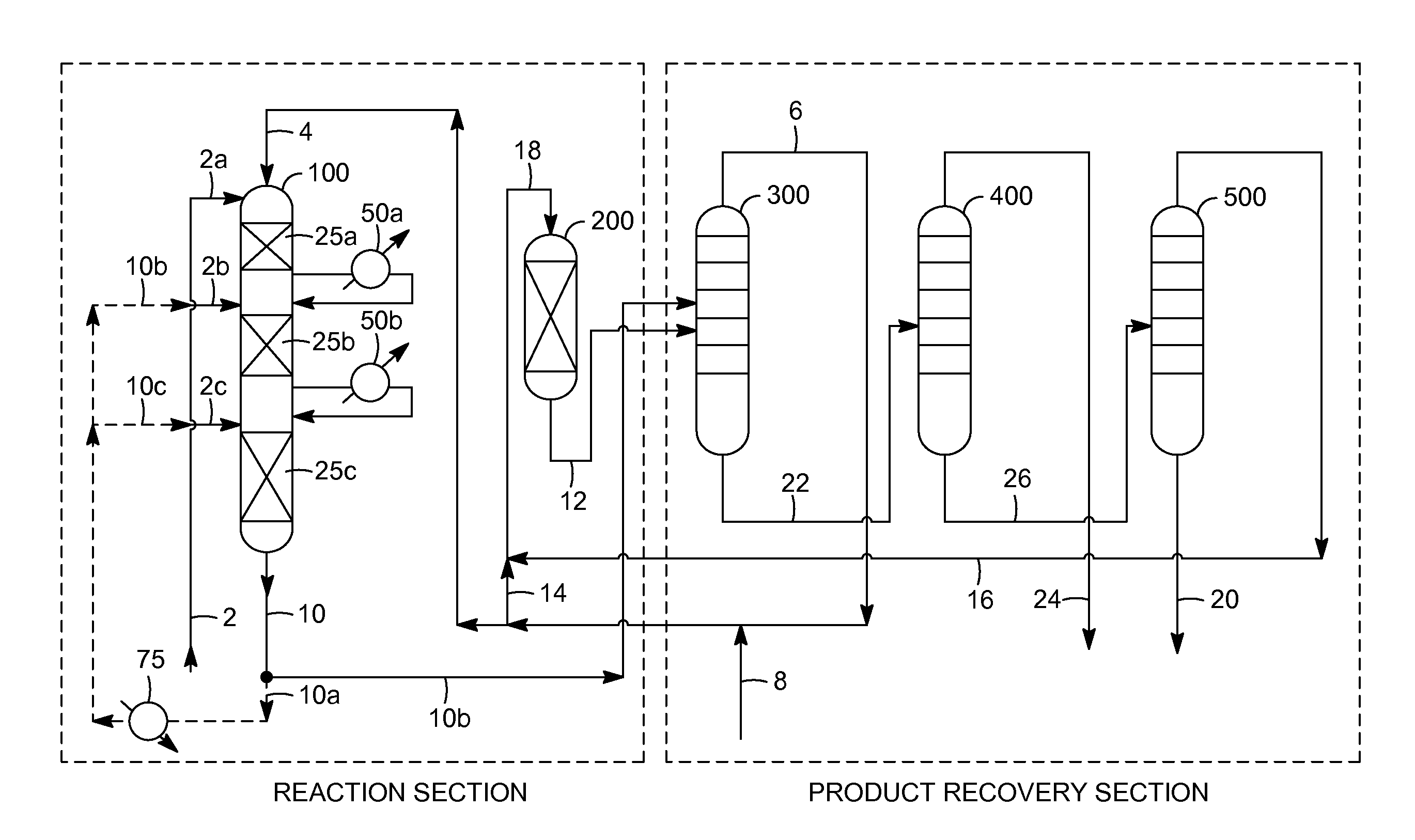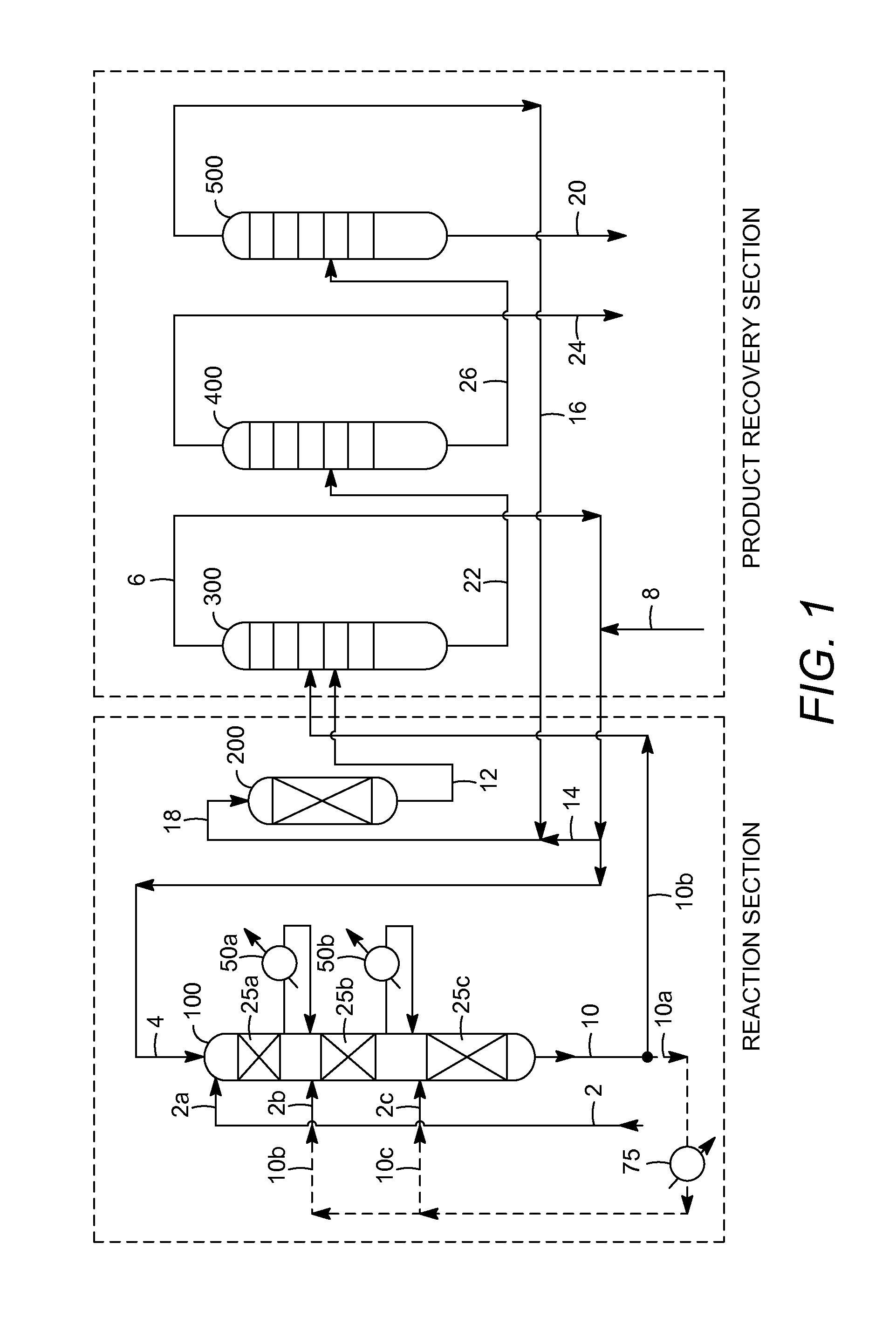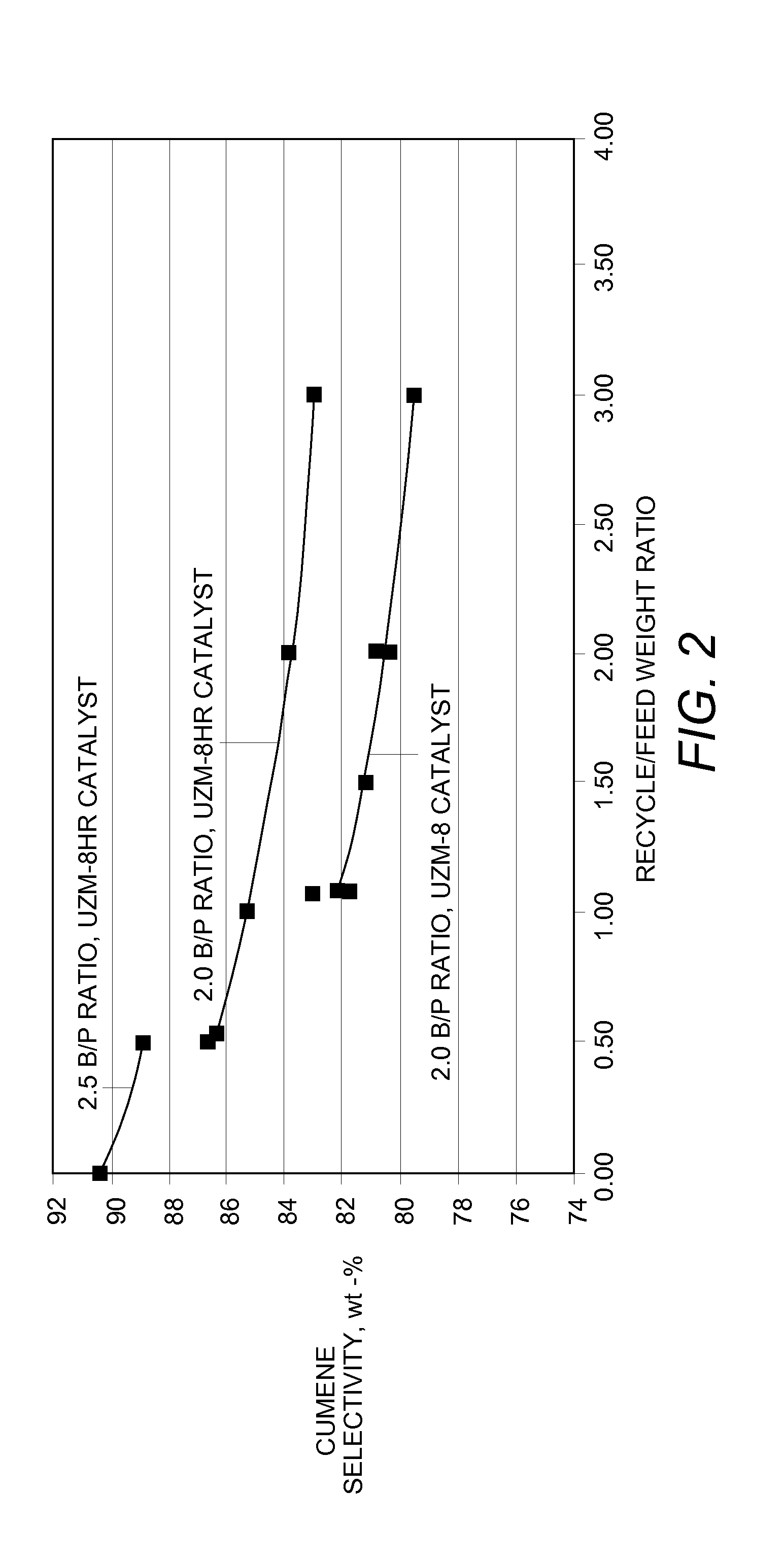[0008]The present invention is associated with the discovery of cumene production methods, based on the alkylation of benzene with propylene, in which byproducts of the alkylation reaction are advantageously reduced to achieve a
high selectivity, for example at least about 85% on a
molar basis, of the total converted products cumene and its dialkylated and trialkylated derivative byproducts (i.e., diisopropylbenzene (DIPB) and triisopropylbenzene (TIPB)), to the desired product cumene. For purposes of this disclosure, therefore, “selectivity” means the ratio of moles of cumene:moles of total (cumene+DIPB+TIPB) in the alkylation effluent or product from the alkylation reaction zone. Moreover, it has also been determined that, according to particular embodiments, this high cumene selectivity is achieved using an economically benzene:propylene molar ratio of the alkylation feedstock, for example at most about 2.5:1. The selectivity improvement is associated with a number of advantages, in terms of
process economics, related to reduced operating and equipment costs for recycling, converting, and / or separating undesired byproducts. These and other process features are beneficially combined with particular alkylation catalyst systems, and particularly catalysts having a framework Si / Al2 molar ratio in the range from about 24 to about 35.
[0009]
High selectivity may be attained by reducing the portion of the total alkylation effluent that is recycled, after cooling, to the alkylation reaction zone as a
heat sink to manage the temperature differential across the alkylation reaction zone or across individual alkylation catalyst beds within this zone. Reducing the recycle ratio in the alkylation reaction zone can beneficially prevent the re-introduction of at least some of the cumene into a reaction environment that promotes its further alkylation to non-selective byproducts such as diisopropylbenzene (DIPB) and triisopropylbenzene (TIPB). Thus, while effluent recycle is conventionally used to limit the maximum alkylation reaction zone temperature and consequently the rates of non-selective reactions (e.g., to produce normal-
propylbenzene (NPB) and
ethylbenzene (EB) byproducts), this benefit is achieved at the expense of obtaining an alkylation effluent comprising cumene at well below the equilibrium level of a cumene / DIPB / TIPB mixture under the alkylation reaction zone conditions.
[0011]Other aspects of the invention relate to improvements in cumene selectivity resulting from reducing the benzene:propylene molar ratio of the alkylation feedstock entering the alkylation reaction zone (e.g., entering an alkylation reactor at multiple locations corresponding to inlets of multiple beds of alkylation catalyst). Especially surprising is that a combination of a reduced benzene:propylene molar ratio (e.g., at most about 2.5:1) and a reduced alkylation effluent recycle ratio (e.g., at most about 3:1) can result in a dramatic improvement in cumene selectivity in the alkylation reaction zone, with an exemplary selectivity being greater than about 85%, typically greater than about 88%, and often being greater than about 90%, by weight.
[0013]Further aspects of the invention relate to the discovery of operational
synergy between the alkylation reaction zone, with the high cumene selectivities as discussed above, and the
transalkylation reaction zone and / or
product recovery section that results in overall significantly improved
process economics. Advantageously, high cumene selectivity in the alkylation reaction zone (e.g., greater than about 88%), and especially at particular benzene:propylene molar ratios of the alkylation feedstock (e.g., from about 2.2 to about 3.0), can decrease the yield loss of net benzene and propylene that are converted to TIPB and higher molecular weight byproduct compounds to generally less than 1%. At sufficiently low production of TIPB, the conventional distilling, in the
product recovery section, of the higher boiling byproduct fraction (obtained from recovering cumene product as a lower boiling fraction) can be carried out (e.g., in the DIPB column) at
atmospheric pressure or above, rather than under
vacuum pressure as performed conventionally to recover TIPB together with DIPB in the lower boiling (e.g., overhead) fraction that is fed back to the
transalkylation reaction zone.
[0014]According to embodiments of the invention, therefore, the yield loss of TIPB may be reduced to an extent that the
cost savings associated with operating
distillation in the DIPB column at
atmospheric pressure or above, rather than under
vacuum pressure, surpass the relatively smaller expenses associated with removing the TIPB byproduct, rather than recycling this compound to the transalkylation reaction zone for production of additional cumene. According to other embodiments that
exploit high cumene selectivity and particularly the low net production of TIPB in the alkylation reaction zone, the transalkylation catalyst advantageously comprises beta
zeolite that, unlike conventional transalkylation catalysts, does not require the presence of TIPB in the transalkylation reaction zone to prevent a net production of this compound. Importantly, beta
zeolite is shape selective and can therefore be used in a transalkylation reaction zone operating at a DIPB conversion of at least about 60%, compared to conventional conversion levels of only 50-60%, without a significant production of transalkylation byproducts such as normal-
propylbenzene (NPB) and
ethylbenzene.
 Login to View More
Login to View More 


